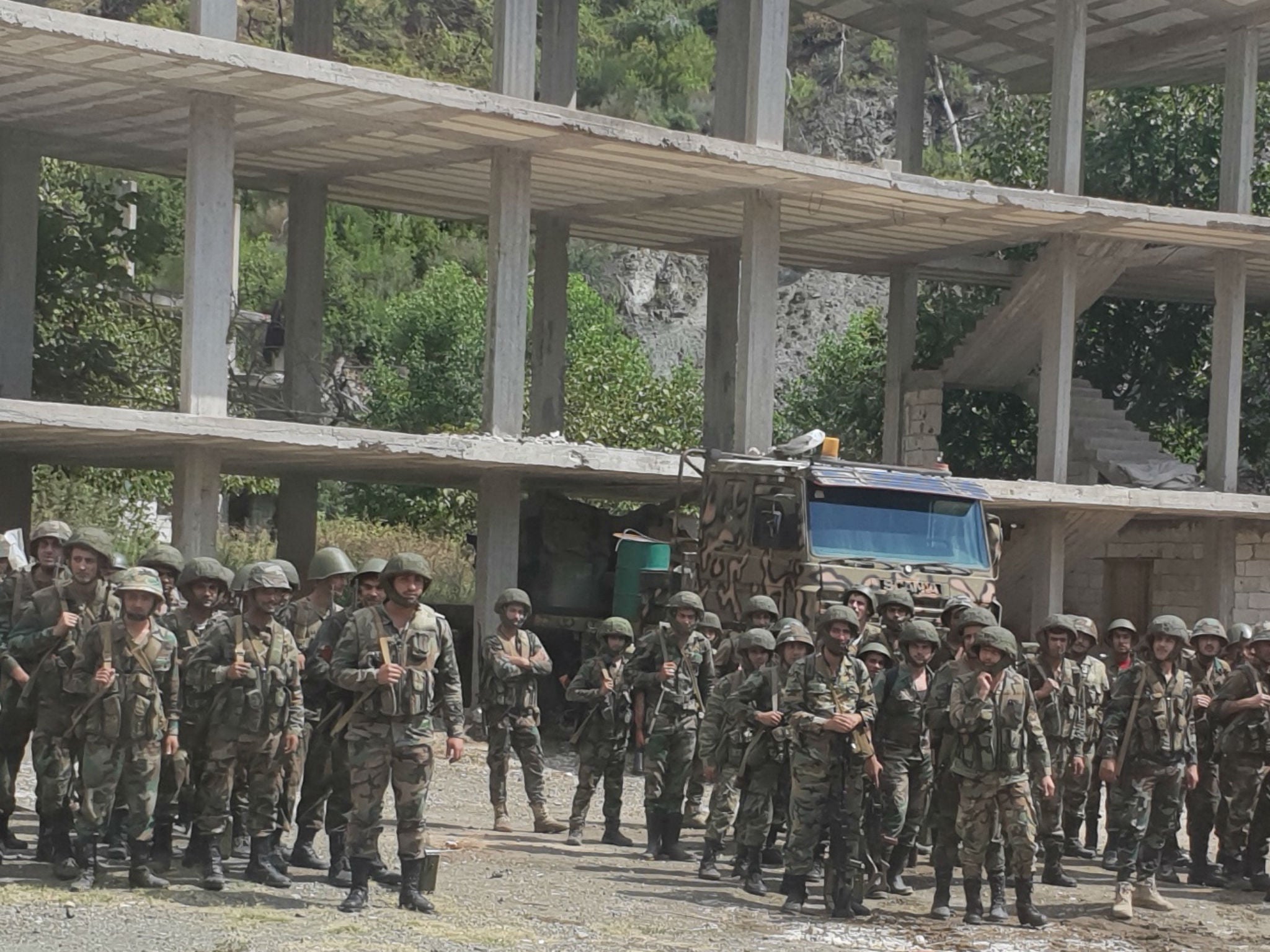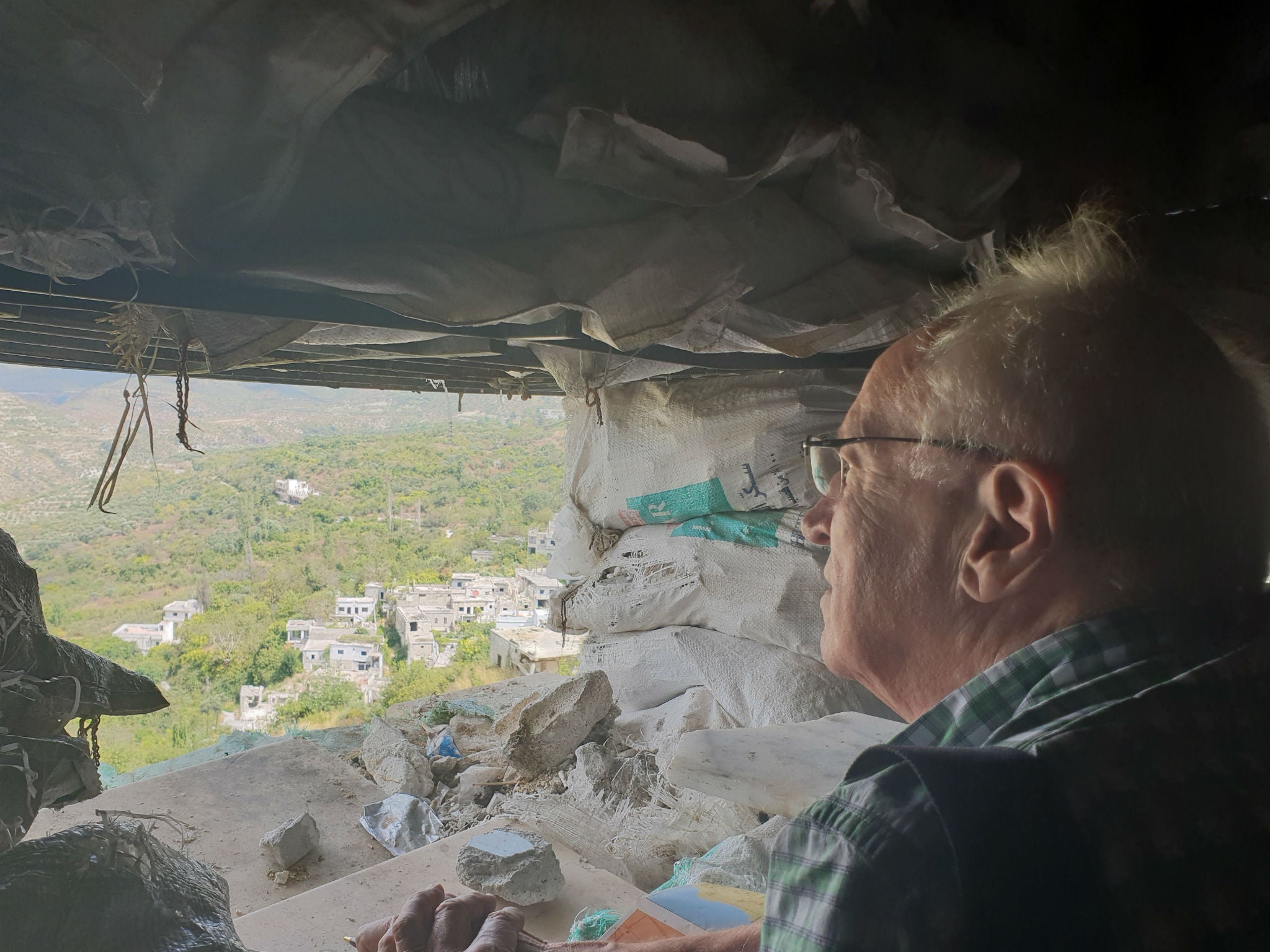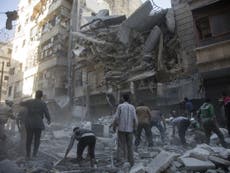After warnings of mass murder and catastrophe in Idlib, I prowled the front lines for two days. I didn't find what I'd expected
The only massed forces I came across were vast herds of sheep and, close to Aleppo, a string of camels. War might be coming, but not yet


Every journalist would like to start a report with the words: “All quiet on the western front.” Or the eastern front. And I had actually scribbled “all quiet on the northern front” in my notebook, on my rural way to the far northern village of Kansabba on Syria’s front line opposite Idlib province, when an artillery piece in the forest banged off a shell over our heads. It took 25 seconds for the sound of the explosion – on the hills to the north-east – to echo softly back to us through the trees. Then a second round. And a third. A few Syrian soldiers on motorcycles purred along the road. Front lines are like this. Sunlight, lots of clouds, a winding country lane way, an explosion and then a herd of sheep drift out of a field at the bidding of a cowled shepherd.
So goodbye to the “all quiet” bit. But here’s the problem. Syria makes no secret that it has amassed 100,000 troops around Idlib province for the “last battle” against its Islamist enemies; give or take any who can be persuaded to “reconcile” with the Syrian government via the Russians, go “home” – Tajikistan, Saudi Arabia, Afghanistan, Chechnya, you name it – or surrender. And as we all know, a lot of the jihadis in the Idlib “terrorist” dustbin – the Russians and Syrians use “terrorism” now with all the alacrity that George W Bush deployed after he invaded Iraq – preferred to battle on in Idlib after leaving the big cities of Syria.
Then there are the “experts” in the West who tell us that there are 30,000 fighters in Idlib. I suspect closer to 10,000. Civilians, we are informed, compose between 2,500,000 and three million of the souls in Idlib; half a million of them, in other words, may or may not be there. The civilians trapped in eastern Aleppo turned out to be a gross exaggeration once the siege ended in 2016. But maybe the higher figure in Idlib is the right one. And how do we know that 100,000 Syrian soldiers is the correct statistic? But if so, it is the largest massing of Syrian troops since the start of the war.
Thus Trumpian-UN-Merkel-Erdogan warnings of humanitarian catastrophe, mass murder, chemical attack and Armageddon had me prowling along Syrian front line roads for all of two days; yet the huge Syrian invading force remained oddly elusive. I travelled from the Turkish frontier at Kassab, through Rabia and Kansabba and behind Jourine and then up the Syrian military supply route from Hama to Abu Adh Duhour and through villages unheard of outside Syria – Omalhouteh, Tel Maseh, Ewanat Skieh, Bardah, Kafr Abeed, Blass, Alhadein – and the massed Syrian army was nowhere to be seen.
Was this really the start of the last battle, I kept asking myself? Amid a sylvan grove east of Kassab, I suddenly came across 200 Syrian troops, steel helmets, arms at attention, on parade – their commander sent a motorcycled soldier after us to ask why we were taking photographs – for this was, to be sure, a good Boys’ Own Paper picture for The Independent. Readers, please note my colleague’s snatched snapshot with this dispatch. But there were no armoured vehicles, no Iranians, no Hezbollah, no Russians, no convoys of field artillery – though I had seen the photos of the Syrian convoys a couple of weeks ago – and the only massed forces I came across were vast herds of sheep and, close to Aleppo, a string of camels. Not a single soldier was carrying a gas mask. Which would surely be a sure sign of an imminent chemical attack anywhere on the front, whoever was dropping the stuff.
Now this doesn’t mean the invading army wasn’t there. Perhaps far behind the front lines or far above Aleppo, waiting in faraway fields for zero hour, they may be passing their time. The Syrians have loudly announced their intention of crushing the last Islamist bastion in Idlib – and I can confirm that Syrian jets took off from the Hama air base on Saturday morning at around 8.30 because I could hear their roar a mile away over breakfast – but I saw no smoke clouds drifting down from Jisr al-Chougour or east of Idlib a couple of hours later as I watched from that all-too-smashed security-supply route up to Aleppo. A lone, low-flying Russian-made Syrian helicopter came thudding over the desert near Abu Adh Dahour, whose own air base was recaptured by Syrian troops last year. Just one.
So here’s what I did find on my 300-mile tour around the frontier of Idlib. At the old Kassab border crossing, the Turks are still building a massive concrete wall along the Syrian frontier, topped with barbed wire and arc lights below a cloud-shrouded mountain on which stood, just visible, a range of reconnaissance aerials. From there, a Syrian captain told me, Nato watched Syria and could probably listen to Syrian communications – although the Syrians could apparently not listen to Nato. I climbed the staircase of a broken house, its former Nusrah Islamist forces’ graffiti painted out on the internal walls – and stared across the Turkish border. There was even a bust of Mustafa Kemal Ataturk on the Turkish side of the frontier station.

Then a sense of déjà vu. A group of Syrian security agents walked sullenly towards us to ask the Syrian army what we were doing. There was an altercation – an instructive moment – between the two Syrian forces before we moved away. Interesting. But exactly two years ago, the same Syrian army had been confronted by the same security men at the same spot asking the same question about my presence. Not a bad repeat performance. And when I drove further east, those guns began firing across the forest, yet – again, exactly two years ago, at this very spot – the Syrian artillery – quite probably the very same guns – had lobbed off shells over our heads at the same distant Nusrah-held hillsides. Plus ça change, I suppose.
And then, near Kansafet, I climbed the crumbling steps of a shell-scarred villa where the Syrian front line troops manned sand bags above a smashed mosque and a smashed church and a bullet whacked past us from the Nusrah snipers above. When I suggested to an obliging Syrian officer that I thought there might be no great offensive – just a slow gnawing away at the boundaries of Idlib’s mini-caliphate while “reconciliation” talks dragged on between the Syrians and the Russians and the Turks and the armed groups and, hopefully, the tens of thousands of civilians trapped there – the soldier nodded and told me I was “50 per cent correct”.
It was an eerie journey. A vast empty motorway – its blue Aleppo, Lattakia and Damascus road signs proving it to be the old international M4 highway cut off by the Idlib fighters; a towering railway viaduct captured by the Syrian army; and a massive but still incomplete concrete river dam whose equipment, so the Syrians say, was stripped by Nusrah and sold to the Turks. And thousands and thousands – and thousands more — abandoned, crushed houses and cattle sheds and huts destroyed over the past three years of fighting. Nusrah had tried to bring down a motorway bridge, but their charges – exploded long ago – appeared to have blasted downwards rather than upwards, and the structure still stood.
It was around this time that I realised the purpose of the Syrian army’s presence in this sector. Not, I suspect, for an offensive against Idlib, rather to fight off opposition fighters if they were under air bombardment and tried to escape west and cross the walled Turkish border. If there is to be a last battle, Syria’s armed enemies are not supposed to slip away this time – unless, of course, the Russians and the Iranians and the Turks – basking in the aftermath of the only slightly successful Tehran talks last week – can still work out a peaceful settlement.
So this was no launching pad for an attack against Idlib. “This place is so full of mountains, valleys, hills and rocks, it would need six divisions to fight here and we’ve only got one,” a Syrian officer vouchsafed. In any case, I asked myself, how can you start an attack with massed tanks through a forest? And you can forget historical memories of the Ardennes. These forested hills are far more difficult to cross, let alone plunge down – in the style of Byron’s Assyrians – like the wolf on the fold.
On the further mountains, a clutch of elderly T-62 tanks of Warsaw Pact vintage nestled beside the road amid 80mph winds. The military road east of Idlib province, cratered and lined with the same shattered villages, was marked only by the now familiar red, white and black flagged Syrian checkpoints and flanked by vast basins of desert. Save for the lone helicopter, there was no sign of imminent catastrophe for the people or the defenders of Idlib. The sand appeared to be that cliché of all war reports – a deserted desert – and the horizon was 15 miles away. Could Syria’s legions be out there in the shimmering heat, waiting to strike? Quite possibly, but I thought I should have spotted some of them. Out of Aleppo, six heavy duty supply trucks, new imports from Russia, ground up a hill. They were all empty.
The villages along this tour of the front lines were as miserable as they were depressing. Largely abandoned, several, on the last stage of the journey, still boasted the remains of Nusrah’s illicit oil pumps – a mass of broken ironwork with black stains around them – but a few stores had reopened, closer to Aleppo. But who would want to return here when the last successful Syrian offensive in Deraa had ended with a mysterious Isis incursion in which scores of Druze civilians were slaughtered?
Well, I took a return journey down the supply route. Forty soldiers in a corrugated iron shed coffee shop, five helicopters – one reconnaissance – hovering around the recaptured airbase – a longstanding radar position – and four covered non-military trucks. Not much evidence of “Operation Dawn of Idlib” as the Syrian army are now officially calling it.
Well, you can’t have a war without a war. However true or illusory the reports are of heavy air raids in Idlib – and it remains a fact that not a single Western journalist reporting them is, so far we know, in Idlib itself – it would be ridiculous to suggest that the Russians and Syrians are not bombing the province and its cities. They are. Touring the front on military roads, as I have just done on the Syrian side of the line, does not mean that I can see every valley and wadi or spread of desert. It is a fact that there are several Russian observation posts here – but I did not see them. And one Turkish post, installed under the Russian “de-escalation” agreement, which I could not find.
My guess is that the “last battle” is still a while away. It must happen, surely. The Syrian government has said repeatedly that it will not permit its enemies to stay in a province of 6,097 square kilometres – warning, even THAT statistic might be a trifle too high! – but Syria does not want to go to war with Turkey.
Will the Turks, who allowed so many of these men into Syria, survey the future battlefield and be intimidated by the massed Syrian army (for they can assuredly survey it better than me)? No, I don’t think Turkey will be intimidated. But with Vladimir Putin’s hand on his shoulder, the Sultan Erdogan across the border might be a little more accommodating. Perhaps someone will take back the foreign fighters. Or send them to fight and die in another country. Libya, perhaps? Yemen? These men – and their families — have moved around the Middle East quite a lot these past years. There’ll be more negotiations, I suspect, between Putin and Erdogan and Assad and – through Putin – perhaps with the Saudis? Meanwhile, our leaders huff and puff and froth and roar and – across that little valley, be sure Syria’s guns continue to fire this morning. It’s not all quiet on the northern front, then. But not yet war.

